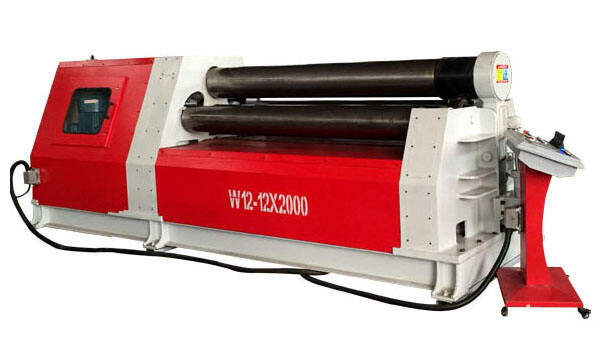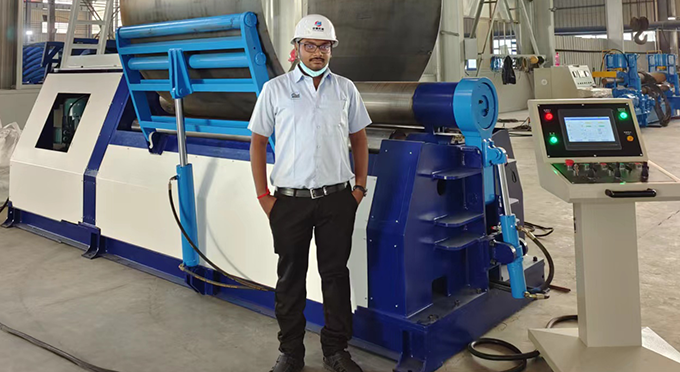Profile Bending Machine Fundamentals
Core Components: Rollers, Hydraulic Systems, and CNC Controls
Rollers serve as the backbone of profile bending machines, playing a crucial role in shaping various profiles with precision. They apply force to bend metals into desired angles and curves, ensuring that structural components have the needed geometry for their applications. Rollers are available in different configurations, such as three or four roller systems, which determine their efficiency and the smoothness of the final product. Moreover, hydraulic systems provide the necessary force to drive these rollers effectively, offering advantages like increased efficiency and reduced physical labor. The hydraulic power eliminates manual exertion and ensures consistent force, which is vital for maintaining uniform bending angles. Advanced profile bending machines incorporate CNC controls to enhance accuracy and repeatability in profile bending operations. These controls allow operators to program specific bending sequences, ensuring each profile is bent precisely to its specifications. This automation not only improves productivity but also guarantees consistent quality across different batches.
Types of Profiles: Beams, Channels, Angles, and Tubes
Profile bending machines are versatile tools capable of processing various types of profiles, including beams, channels, angles, and tubes. Each type has its unique geometry and application, catering to the specific needs of different industries. For instance, I-beams are primarily used in construction for structural support due to their high load-bearing capacity. U-channels are often found in manufacturing and automotive applications, providing support and framework. L-angles are common in construction and furniture manufacturing, offering stability and design flexibility. Round tubes are prevalent in industries that require fluid transportation, such as plumbing and automotive exhaust systems. According to industry reports, construction and manufacturing sectors are the biggest consumers of these profiles, leveraging their varied applications to meet demanding structural requirements. A study published in the Global Construction Review indicated that the use of steel beams is projected to grow significantly, driven by increasing infrastructure development.
Material Compatibility: Steel, Aluminum, and Stainless Steel
Understanding the material compatibility of profile bending machines is essential for selecting the right machine for the job. Steel, aluminum, and stainless steel are commonly used materials due to their desirable properties for bending. Steel, known for its strength and durability, is often used in heavy-duty applications such as construction and automotive frames. Aluminum, with its lightweight and corrosion-resistant properties, is preferred in industries like aerospace where weight savings are crucial. Stainless steel offers a balance of strength and corrosion resistance, making it suitable for medical and food processing applications. However, some materials can be more challenging to bend, such as high-strength steels, which require advanced techniques like induction bending to manage their rigidity and springback. Industry data highlights that steel remains the most popular choice due to its cost-effectiveness and versatility, but there is a growing preference for aluminum in sectors prioritizing sustainability and efficiency.
Key Considerations for Selecting a Profile Bending Machine
Profile Dimensions and Bend Radius Requirements
Understanding the dimensions of profiles is crucial in the bending process, as they directly influence the type of machine and setup required. The length, width, and thickness of profiles dictate how the bending rolls must be adjusted, impacting the machine's precision and efficiency. Industries such as construction often demand specific dimensions for architectural elements like beams and angles, requiring machines capable of accommodating diverse shapes and sizes. Bend radius is another vital aspect, as it determines how smoothly a profile can be curved without compromising its structural integrity. Selecting the right machine involves assessing its capability to meet the bend radius necessary for the application. For instance, automotive sector components frequently require tight bend radii to fit into compact structural designs.
Hydraulic vs. Electric Bending Capacity
When choosing between hydraulic and electric bending machines, we must consider factors like energy efficiency and force application. Hydraulic machines, known for their robust power, excel in handling heavy-duty tasks and large profiles, providing enhanced force and reliability. Conversely, electric machines offer superior energy efficiency, reducing operational costs over time. Industries like aerospace often prefer electric machines for their precise control and efficiency in handling varied materials. However, hydraulic machines find their place in applications demanding higher force and quick operations, such as in shipbuilding. Market trends indicate a growing inclination toward hydraulic solutions, driven by their versatility and strength in significant industrial applications.
Automation Needs: Manual vs. CNC-Controlled Machines
The trend towards automation is reshaping manufacturing, enhancing operational efficiency and precision. CNC-controlled machines offer substantial benefits in terms of accuracy and repeatability, significantly reducing labor requirements compared to manual systems. While manual machines provide more control for small-scale operations, the investment in CNC technology is justified by the long-term benefits of consistent outputs and reduced labor costs. Expert opinions often favor CNC machines for their ability to execute complex designs with minimal errors, making them ideal for high-demand sectors like automotive and aerospace. Studies have shown that the initial expenses of CNC integration are offset by increased productivity and precision, proving a worthwhile investment.
Comparing Roll Configurations (2-Roll vs. 3-Roll vs. 4-Roll)
2-Roll Machines: Precision for Thin Materials
2-roll machines are specifically designed for precision bending of thin materials. The mechanics of these machines involve pressing the material between two rolls to achieve the desired curvature. This process ensures a high degree of precision which is essential for materials where thickness restrictions play a critical role. However, these machines primarily excel with thinner metals and struggle with thicker or more sturdy materials due to limited force application. Examples of where 2-roll machines are preferred include applications in the automotive industry where components require refined detailing without the need for excessive force, such as in crafting car panels or exhaust systems.
3-Roll Machines: Versatility for Medium-Duty Applications
3-roll machines offer versatility and efficiency for medium-duty bending applications. They function using three rolls, with the central roll exerting pressure on the material while the outer rolls act as stabilizers, providing adaptability for various profile sizes and shapes. Industries such as construction and manufacturing favor 3-roll machines due to their capability to handle diverse projects with consistent results. For instance, medium-duty bending is often required in fabricating structural supports and rails where versatility in material sizing is necessary. With performance metrics showing improved material handling and reduced cycle times, these machines demonstrate optimal effectiveness across different mediums.
4-Roll Machines: Heavy-Duty Plate Rolling Efficiency
In heavy-duty applications, 4-roll machines stand out by delivering superior performance in handling larger thicknesses and dimensions. The four-roll configuration enables precise material control throughout the rolling process, significantly reducing material wastage. This setup is advantageous in industries requiring substantial material strength, such as shipbuilding and construction where large steel frames must be shaped with minimal room for error. The robust nature of 4-roll machines ensures that they outperform others by maximizing operational efficiency, particularly when crafting large-scale components like hull sections or structural beams, creating a reliable foundation for heavy-duty projects.
Advanced Features & Automation Options
CNC Plate Bending Technology for Repeatable Accuracy
CNC plate bending technology is revolutionizing the way we achieve precision and repeatability in bending processes. By incorporating programmable settings into bending machines, operators can easily configure complex tasks with remarkable accuracy. These settings allow for the automation of various bending parameters, significantly reducing manual intervention and error. For instance, companies such as Durmazlar have seen an increase in efficiency and production accuracy by integrating CNC systems into their operations. This has led to reduced setup time, minimized waste, and enhanced product consistency, proving the valuable impact of CNC technology in today’s competitive industrial landscape.
Integration with Hydraulic Shearing Systems
Integrating bending machines with hydraulic shearing systems enhances operational efficiency and streamlines workflow. Such integration allows for seamless transitions between bending and shearing tasks, reducing processing time and material handling. This combination enables projects to maintain consistency and quality from start to finish. Industries that focus on high-volume production, such as automotive and construction, benefit greatly from these integrated systems. They leverage the smooth workflow to cut down cycle times and boost overall productivity.
Maintenance Tips for Long-Term Performance
Regular maintenance is crucial for ensuring the longevity and optimal performance of bending machines. A comprehensive maintenance checklist should include practices like consistent lubrication of components, routine inspections for wear and tear, and timely replacement of worn parts. Lubrication helps prevent friction and overheating, while inspections help detect any potential issues early on. Experts recommend conducting maintenance checks at least annually, or more frequently, depending on usage. Avoid neglecting these practices, as even minor oversights can lead to significant operational setbacks. By adhering to these tips, operators can sustain their bending machines' efficiency and reliability for years.
Table of Contents
- Profile Bending Machine Fundamentals
-
Key Considerations for Selecting a Profile Bending Machine
- Profile Dimensions and Bend Radius Requirements
- Hydraulic vs. Electric Bending Capacity
- Automation Needs: Manual vs. CNC-Controlled Machines
- Comparing Roll Configurations (2-Roll vs. 3-Roll vs. 4-Roll)
- 2-Roll Machines: Precision for Thin Materials
- 3-Roll Machines: Versatility for Medium-Duty Applications
- 4-Roll Machines: Heavy-Duty Plate Rolling Efficiency
- Advanced Features & Automation Options




